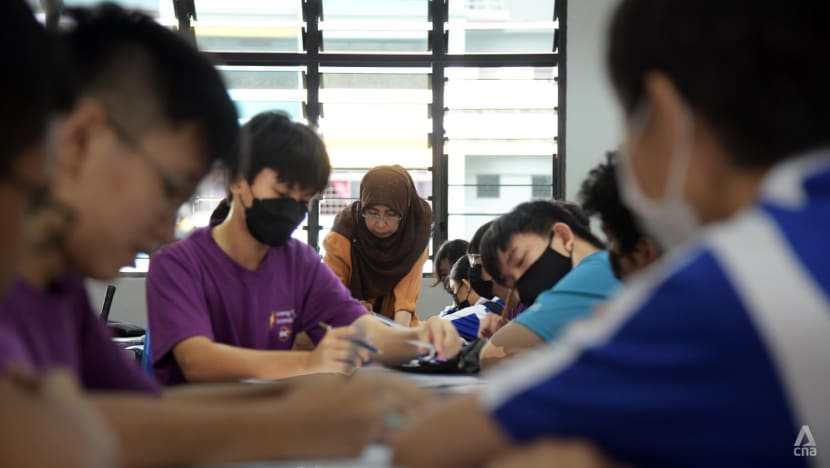7-day work weeks, marking while at home: Singapore teachers say they're as busy as ever if not more
A survey found that educators in Singapore are more stressed than the global average.

Secondary 2 students in a mathematics lesson in their subject-level class. (File photo: CNA/Raydza Rahman)

This audio is generated by an AI tool.
SINGAPORE: As an English and mathematics teacher in a Singapore primary school, Heidi starts her day at 5.30am.
Classes start two hours later and run until about 1.30pm when school ends. Three times a week, she holds remedial classes until about 3pm. After that, or co-curricular activity commitments, she marks assignments until 5pm.
“Two to three times a week, I continue working in the evenings. On Saturday and Sunday, I also spend an hour or two planning lessons and marking as well. Actually, I would say I do work seven days a week,” she told CNA.
“It really has affected my time with my family members because I’m literally marking while I’m at home.”
Earlier in October, an OECD teaching and learning international survey found that educators in Singapore worked longer hours and were more likely to experience a lot of stress compared to the global average.
Like Heidi, teachers CNA spoke to said their overall workloads have either remained the same or increased, despite the Ministry of Education's (MOE) attempts to tackle this issue.
All the teachers agreed to be interviewed for this article on condition of anonymity, as they are not authorised to speak to the media.
Measures that have been rolled out in recent years range from efforts to reduce examination administrative loads to investment in automated marking and artificial intelligence assessment tools.
But one thing that has made a notable difference was former Education Minister Chan Chun Sing setting baseline expectations for communication, the teachers told CNA.
In September 2024, he said teachers should not be expected to respond to work-related messages outside of school hours, except in emergencies; and that he did not expect them to share their personal mobile numbers with parents.
Nick, who teaches English and literature in a secondary school, chose to give his phone number to parents anyway, for "convenience". He said he used to get emails, messages and calls outside of work hours.
But after Mr Chan “set the tone”, which was backed by a school-wide understanding, it has helped to reduce stress, Nick added.
IMPROVED PROCESSES BUT NEW EXPECTATIONS
In a joint statement to CNA, representatives from Singapore's four teachers' unions noted that educators generally agree that MOE's measures have been helpful in specific areas – for instance, grading is faster and paperwork is less onerous.
Teachers CNA spoke to highlighted the Parents Gateway online platform, which has made collecting consent forms and medical certificates slightly smoother; as well as artificial intelligence tools for writing testimonials, which have saved time.
But these measures have not dramatically lowered teachers’ overall workload, as aspects such as task mix or intensity may have shifted, and teachers also often use freed-up time for more value-added work, said the Singapore Teachers’ Union, Singapore Chinese Teachers’ Union, Singapore Malay Teachers’ Union and Singapore Tamil Teachers’ Union.
“From a policy perspective, this shifts effort to higher-impact activities, but teachers may still feel their workload is as heavy as before,” said the unions. "Many would argue that the core pressures of the job – long hours, numerous responsibilities – remain unchanged.”
The OECD survey, done in 2024, found that the amount of time Singapore teachers spend on admin work has remained the same since 2018, at four hours per week. The amount of time spent marking dropped by 1.1 hours from 2018, but time spent on lesson planning increased by 0.9 hours.
While teachers no longer have to collect and collate forms manually, calling parents who do not submit the necessary forms one by one, sometimes repeatedly, is still unavoidable, they shared.
“These are time-consuming, manual tasks that technology still can’t alleviate,” Heidi said.
And one new source of administrative work has come from organising events or activities outside of the classroom, teachers said.
Renald, who has been a teacher for more than 10 years, noted that these are part of key performance indicators. For example, for teachers to be promoted, they need to show that they have led a team, which they can do so through planning events.
At one school he taught at, teachers and members of a parent support group planned recess activities every one to two weeks. Each event took up “a lot of time” – even a 30-minute activity requires days and weeks of planning, said Renald, who teaches English and mathematics at the primary school level.
“Is it possible to streamline the activities, for MOE to put a foot down and say ‘we’re not event planners, we shouldn’t be planning a thousand events for our students’?”
He added: “Honestly, most of my time is not spent on creating lessons or marking. It’s every other thing that’s taking up all my time, including all the meetings I have to get to.”
Teachers also told CNA that the introduction of subject-based banding and the focus on differentiated learning mean they need more time to prepare for lessons.
Arranging timetables has become more complicated, and teachers have to personalise instructions, feedback and assessments for all the different student profiles in each class, they said.
Compared to years ago, the focus is now more on pedagogy when designing lessons. “Last time when we were students, teachers could just walk in with a textbook and start teaching,” said Jamie, who teaches Chinese in a primary school.
“Now, you have to prepare slides, (tech) tools for the kids ... there’s a lot of behind-the-scenes work.”
For a class of 20, she typically prepares three different sets of learning materials to account for students of different abilities, which doubles preparation time.
The process is helped "slightly" by using ChatGPT to come up with ideas for lessons; but because she has to prepare more materials, it does not feel like her workload has decreased, said Jamie.
She noted that on top of spending nine to 10 hours a day in school, most teachers also take very short lunch breaks.
She usually grabs something from the school canteen or through food delivery services, and eats at her desk while continuing to mark assignments. “It’s quite sad.”
RESPONSIBLE FOR STUDENTS' PERFORMANCE
Too much admin work and too much marking were listed in the OECD survey as the top two sources of stress for Singapore's teachers.
MOE's Student Learning Space allows for online assignments that can be graded automatically, but teachers CNA spoke to had mixed feelings on the online platform.
For one, automated marking tools are only suitable for certain assignments and certain subjects. With English or literature, the tools can handle straightforward editing or comprehension exercises, but open-ended ones like essay writing are more complicated, Nick said.
Jamie added that while the Student Learning Space is meant to reduce workload, designing lessons using the platform is "actually very tedious" and "not really that effective”.
She said she often stays back to attend training sessions for new tools being introduced to the system.
In some schools, leaders may also wish to reduce device usage and fall back on pen and paper assignments – which have to be marked by hand.
Then there are situations where some parents expect teachers to give students homework every day, according to Heidi.
“We have parents who question us, ‘how come there is not enough homework given?’”
“So to fulfil these expectations, we churn out (more homework), then it’s like a vicious cycle because when I give out more work, I have to mark more as well.”
The third most common source of stress for teachers was being held responsible for student achievement, the OECD survey found.
Their performance is assessed based on how much impact they have on their students and the school; not just in the classroom but for CCAs and other activities they manage.
Wendy, who teaches secondary school students, had her performance grades marked down after her students “didn’t do well”.
“Even though you already arrange for extra lessons or remedial lessons for them, there are people who choose not to turn up because they have other extra classes or they don’t want to come,” she said.
“But your bosses still feel that you are in a way at fault because your class did not perform.”
Jamie also noted that teachers at times cannot control how students behave.
And with bullying cases in the spotlight in the past year, there are now higher expectations for teachers to deal with disciplinary cases, they told CNA.
Previously, Jamie would deal with disciplinary issues by spending five to 10 minutes speaking to a student who behaved badly.
Now, there are different categories for discipline issues and depending on the severity, teachers have to write reports, follow up with the students’ parents and go through reflections with the students.
Managing the emotions of a whole class of children can be stressful and emotionally taxing, said Renald, highlighting that disciplinary cases, too, are now an additional source of administrative work.
Teachers themselves are starting to become parents to the students in their classes, with the students' own parents working very long hours, he suggested.
“Maybe the answer to relieving the teachers’ workload is something Singapore has to answer together because a lot of it comes from the high standards of living,” said Renald.
“If we relook that, maybe the parents will be able to spend more time with the kids. The kids get that little bit more attention, they start acting out less, disciplinary cases drop, then the kids become happier.”
















